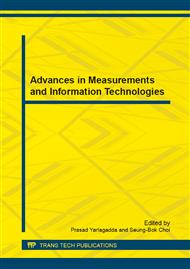[1]
T. Lindblad, J.M. Kinser. Image Processing Using Pulse-Coupled Neural Networks.
Google Scholar
[2]
J. Zhang, K. Zhan, and Y. Ma, Rotation and scale invariant antinoise PCNN features for content-based image retrieval, Journal of Neural Network World, vol. 17, no. 2, pp.121-132, (2007).
Google Scholar
[3]
Tuceryan M, Jain A K.Texture Analysis, Handbook Pattern Recognition and Computer Vision [J]. Singapore: World Scientific, 1993: 235-276.
DOI: 10.1142/9789814343138_0010
Google Scholar
[4]
Ojala T, Pietikainen M, Maenpaa T. Multiresolution gray—scale and rotation invariant texture classification with local binary patterns [J]. IEEE Transactions on Pattern Analysis and Machine Intelligence, 2002, 24(7): 971-987.
DOI: 10.1109/tpami.2002.1017623
Google Scholar
[5]
Harwood D, Ojala T, Pietik¨ainen M, Kelman S, Davis S. Texture classification by center-symmetric auto-correlation, using Kullback discrimination of distributions. Technical report[C], Computer Vision Laboratory, Center for Automation Research, University of Maryland, College Park, Maryland. CAR-TR-678, (1993).
DOI: 10.1016/0167-8655(94)00061-7
Google Scholar
[6]
R. Eckhorn, H. J. Reitboeck, M. Arndt etc., Feature linking via synchronization among distribute assemblies: Simulations of Results from cat visual cortex, Journal of Neural Computation, v2 (3), pp: 293-307, (1990).
DOI: 10.1162/neco.1990.2.3.293
Google Scholar
[7]
J.L. Johnson, PCNN models and Applications, IEEE transactions on neural networks, v10 (3), pp: 480-498, (1993).
Google Scholar
[8]
Johnson J L. Pulse-coupled neural nets: translation, rotation, scale, distortion, and intensity signal invariance for images[J]. Applied Optics, 1994, 33(26): 6239-6253.
DOI: 10.1364/ao.33.006239
Google Scholar
[9]
T. Ojala, M. Pietikäinen, and D. Harwood (1996), A Comparative Study of Texture Measures with Classification Based on Feature Distributions, Pattern Recognition, vol. 29, pp.51-59.
DOI: 10.1016/0031-3203(95)00067-4
Google Scholar
[10]
Do M N, Vetterli M. Rotation invariant texture characterization and retrieval using steerable wavelet-domain hidden Markov models [J]. IEEE Transactions on Multimedia, 2002, (4): 517-527.
DOI: 10.1109/tmm.2002.802019
Google Scholar
[11]
J. Zhang, K. Zhan, and Y. Ma, Rotation and scale invariant antinoise PCNN features for content-based image retrieval, Journal of Neural Network World, vol. 17, no. 2, pp.121-132, (2007).
Google Scholar
[12]
Tuceryan M, Jain A K.Texture Analysis, Handbook Pattern Recognition and Computer Vision [J]. Singapore: World Scientific, 1993: 235-276.
DOI: 10.1142/9789814343138_0010
Google Scholar
[13]
Ojala T, Pietikainen M, Maenpaa T. Multiresolution gray—scale and rotation invariant texture classification with local binary patterns[J]. IEEE Transactions on Pattern Analysis and Machine Intelligence, 2002, 24(7): 971-987.
DOI: 10.1109/tpami.2002.1017623
Google Scholar
[14]
Harwood D, Ojala T, Pietik¨ainen M, Kelman S, Davis S. Texture classification by center-symmetric auto-correlation, using Kullback discrimination of distributions. Technical report[C], Computer Vision Laboratory, Center for Automation Research, University of Maryland, College Park, Maryland. CAR-TR-678, (1993).
DOI: 10.1016/0167-8655(94)00061-7
Google Scholar
[15]
Montoya-Zegarra J A, Beeck J, Leite N, et al. Combining global with local texture information for image retrieval applications[C]. Multimedia, 2008. ISM 2008. Tenth IEEE International Symposium on 2008: 148-153.
DOI: 10.1109/ism.2008.113
Google Scholar
[16]
P.V.N. Reddy, K. Satya Prasad. Content based image retrieval using local derivative patterns [J]. Journal of theoretical and applied information technology. 2011, 28(2): 95-102.
Google Scholar


